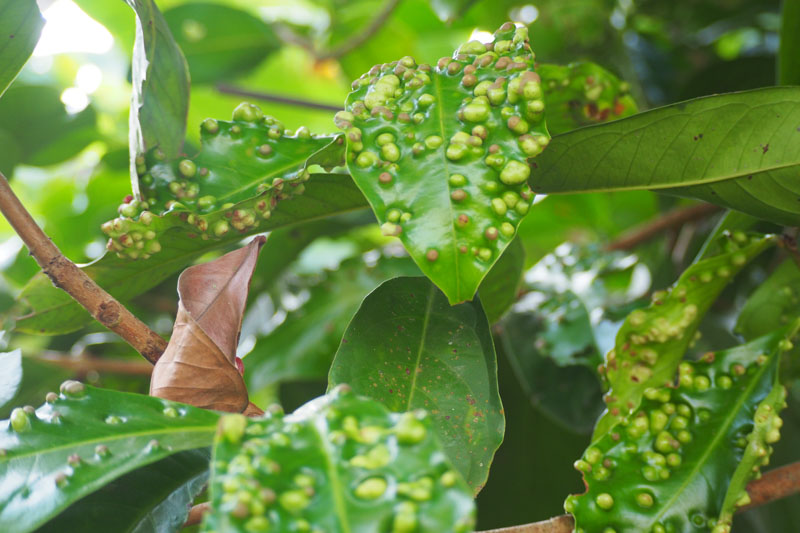Leaf Blister Disease

Leaf blister disease, a condition affecting various plant species, is caused by the fungal pathogen Taphrina caerulescens. This disease manifests as blisters or puckered areas on the leaves of infected plants, often accompanied by a change in leaf color. The blisters, which can be yellow, green, or reddish in hue, are usually found on the upper surface of the leaves, while the lower surface may display a powdery or fuzzy appearance due to the production of fungal spores.
Causes and Symptoms
The primary cause of leaf blister disease is the infection of plants by the Taphrina caerulescens fungus. This fungus thrives in cool, moist environments, making spring and early summer the peak seasons for disease development. The symptoms of leaf blister disease can vary depending on the host plant, but common signs include:
- Leaf Blisters: The most distinctive symptom, these are small, raised, and often discolored areas on the leaves.
- Color Changes: Infected leaves may exhibit changes in color, ranging from yellow to red or purple, particularly around the blistered areas.
- Leaf Distortion: Leaves may become curled, puckered, or otherwise distorted due to the infection.
- Spore Production: On the underside of the leaves, a white, powdery substance may be visible, which is actually the fungal spores.
Impact on Plants
Leaf blister disease can have significant implications for plant health and aesthetics. While it is rarely fatal, the disease can weaken the plant by reducing its ability to photosynthesize, thereby affecting its overall growth and vigor. In landscapes and gardens, the disease can mar the appearance of affected plants, reducing their ornamental value.
Management and Control
Managing leaf blister disease involves a combination of cultural practices, sanitation, and, in some cases, chemical control. Here are some strategies for controlling the disease:
- Remove Infected Leaves: Regularly inspect plants and remove any infected leaves to prevent the spread of the disease. Dispose of infected plant material properly to avoid spreading the fungus.
- Improve Air Circulation: Enhance air movement around plants by pruning surrounding vegetation or moving plants to a location with better air circulation. This helps to reduce moisture, making the environment less conducive to fungal growth.
- Apply Fungicides: In severe cases, applying fungicides specifically labeled for use against Taphrina species can be effective. It’s crucial to follow label instructions carefully and consider the potential environmental impacts.
- Promote Plant Health: Ensure plants receive adequate nutrition, are watered appropriately (avoiding overhead watering which can promote fungal diseases), and are not subjected to excessive stress, as healthy plants are more resistant to disease.
Prevention
Preventing leaf blister disease often involves adopting good gardening practices. Some preventive measures include:
- Selection of Resistant Cultivars: When possible, choose plant varieties known to be resistant to leaf blister disease.
- Sanitation: Regularly clean up plant debris, which can harbor fungal spores.
- Irrigation Management: Water plants at the base, avoiding wetting the leaves, and ensure the soil drains well to prevent waterlogged conditions favorable to the disease.
- Monitoring: Regularly inspect plants for early signs of the disease, allowing for prompt action to be taken.
Conclusion
Leaf blister disease is a notable fungal infection that can impact the health and appearance of various plant species. Understanding its causes, recognizing its symptoms, and employing effective management and preventive strategies are crucial for mitigating its effects. By adopting these practices, gardeners and landscapers can help protect their plants from this disease, maintaining the beauty and vigor of their outdoor spaces.
How does leaf blister disease spread?
+Leaf blister disease spreads primarily through fungal spores that are dispersed by wind or water. These spores can infect plants through wounds or natural openings on the leaves.
Can leaf blister disease be cured?
+While there are treatments to manage leaf blister disease, such as removing infected leaves and applying fungicides, the disease cannot be entirely "cured" in the classical sense. Effective management involves preventing the spread of the disease and reducing its impact on plant health.
Which plants are most susceptible to leaf blister disease?
+Various plants can be affected, but species like oak, maple, and willow are commonly susceptible to leaf blister disease. The susceptibility can vary depending on the specific cultivar and environmental conditions.
By understanding and addressing leaf blister disease effectively, gardeners and plant enthusiasts can better protect their plants and maintain a healthy, thriving garden ecosystem.

